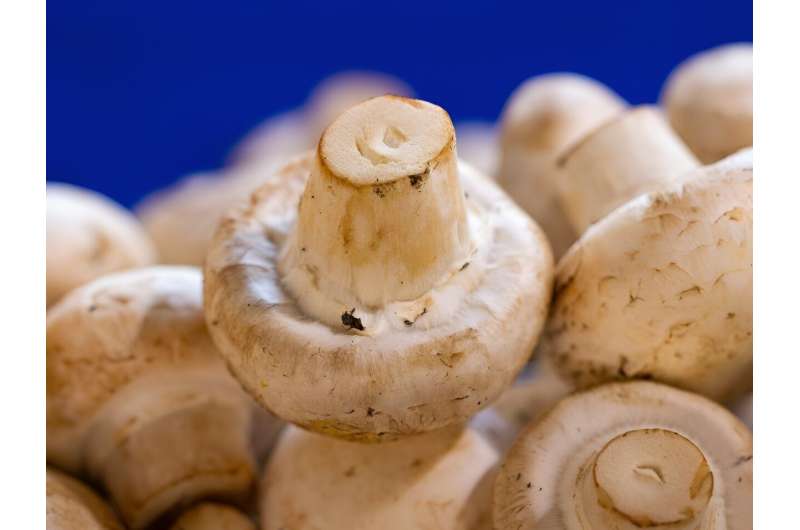Natural compound in white button mushrooms could benefit animal, human health

A team of researchers in Penn State's College of Agricultural Sciences has identified a compound in white button mushrooms that could potentially benefit gut health in mammals by activating a protective biological response.
"Our research showed that a biochemometric approach—modeling chemistry and biology data together—can lead to the discovery of new components of chemical mixture in foods that might be therapeutic for animal and human health," said Joshua Kellogg, assistant professor of metabolomics in the Department of Veterinary and Biomedical Sciences. The researchers published their findings in the Journal of Functional Foods.
Using cell-based assays and a molecular networking approach—a method that organizes molecules according to their structural similarity—the researchers found that the new compound they identified in white button mushrooms activates the aryl hydrocarbon receptor, or AHR, which is found in mammals including mice, pigs and humans.
Prior studies have demonstrated that when mice ingest mushrooms, the AHR either becomes antagonized or inhibited. The compound Kellogg's team identified activates AHR when applied to human and mouse-derived cell lines, which are cultured in the laboratory to test the molecular effects of certain variables.
"It's a delicate balancing act, which is why studying whole foods as well as individual compounds is essential," Kellogg said. "There are benefits to AHR activation as well as antagonism."
Kellogg said that AHR plays an important role in gut health. When activated, it can induce a cellular response to detoxify aryl hydrocarbons, which are known carcinogens, in the gut. When inhibited, AHR can help reduce tumor growth in certain cancers. AHR is also critical in other facets of promoting gut health, including maintaining the integrity of the mucosal lining of the gut and preventing bacteria from invading the gut.
The team's latest research builds on prior work by co-authors Andrew Patterson, professor of molecular toxicology, biochemistry and molecular biology, and Gary Perdew, H. Thomas & Dorothy Willits Hallowell Chair of Agricultural Sciences and director of the Center for Molecular Toxicology and Carcinogenesis. They previously looked at molecules called benzothiazoles and how they react with AHR.
"In our research, we recognized those benzothiazoles, but we also saw previously undiscovered molecules that were structurally related," Kellogg explained. "When we profiled the chemistry of these related structures, we wondered if they would also work with AHR. And we found that they do activate AHR."
The researchers' findings underscore the importance of studying the roles each chemical component plays in a whole food, according to Kellogg.
"Foods are complex chemical mixtures," Kellogg said. "What we do at our core is focus on ways to hunt for active chemistry in natural sources—plants, mushrooms, bacteria. We're interested in how chemical mixtures in foods react with AHR and could protect gut health in general."
Graduate student Xiaoling Chen, a member of the research team and lead author of the paper, is continuing the research by examining at molecular mixtures in other mushroom species.
The team also is applying the biochemometric approach to infectious disease research, Kellogg said. For example, they are screening various plants from regions across Pennsylvania for compounds that act against pathogenic bacteria. They have found phytochemicals—part of a plant's immune system that helps protect against viruses—in the plant Artemisia that seem to be effective at inhibiting the growth of mycobacteria that cause tuberculosis.
More information: Xiaoling Chen et al, Molecular networking identifies an AHR-modulating benzothiazole from white button mushrooms (Agaricus bisporus), Journal of Functional Foods (2023). DOI: 10.1016/j.jff.2023.105602
Journal information: Journal of Functional Foods
Provided by Pennsylvania State University Broccoli consumption protects gut lining, reduces disease in mice, study shows
No comments:
Post a Comment